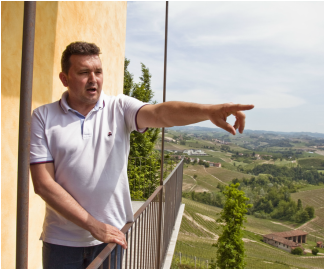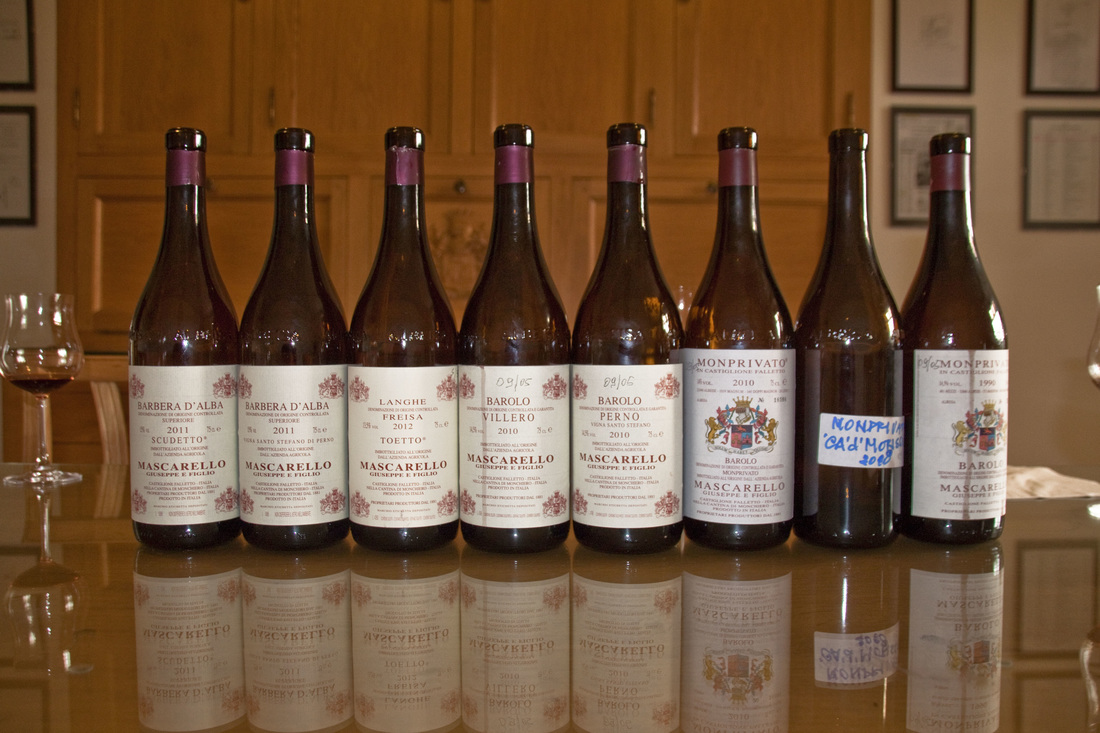Day two ended with a bit of a bang. Dinner in Cissone, at Locanda dell'Arco was lovely with perhaps too many courses: roulade of rabbit, vegetable timbale, quite fine gnocchi swimming in cheese sauce, roasted veal in a sage and hazelnut cream sauce, and panna cotta to finish, but with the wines on deck, 1990 Scarzello Vigna Merenda, and Giuseppe Rinaldi Cannubi-Saan Lorenzo from both 1998 and 1996, we did need something to absorb all the alcohol. The Scarzello was the star of the night, ready and frees, though the 1996 Rinaldi was monumental if too young, and the 1998 perfectly pleasant by itself but a bit sot and diffuse when paired with these two great examples of Barolo.
Day three and we are finally off. Our first visit of the trip, just like last year, was a stop n at Giacomo Fenocchio to meet with Claudio Fenocchio. How these wines have managed to fly under the radar for so long amazes me. While my experience with older vintages is limited, the wines produced here over the last few vintages have been nothing short of fabulous. Totally traditional and with holding in several important crus, this is a producer to watch.
| We began our visit in the barrel room, tasting through the vintages 2014-2012, with a horizontal of all the vintages in 2013 and tastes of the Bussia Riserva from 2011. This is a special wine, not only in 2011 but from 2010 on. Previously the Riserva here had simply been the best lot of Bussia Claudio had in the cellar, he does five separate vinifications from five distinct plots each year. The lot chosen for Riserva each year then saw an additional ten months in both, 40 instead of the 30 that the rest of the Barolo sees. Beginning without he 2010 vintage the vinification of the Riserva changed, seeing an additional 50 days of maceration, making it 90 days instead of 40. |
The results speak for themselves. Added depth, spic, a different level of refinement without he tannins. Put it on your buy list, you wont regret it!
The crus in 2011 are also impressive, if tipping the scales at roughly 15% alcohol, the achilles heel of the vintage perhaps. The Castellero being the least impressive of the three crus, with the Cannubi, Bussia, and Villero all being worthy of further investigation.
The crus in 2011 are also impressive, if tipping the scales at roughly 15% alcohol, the achilles heel of the vintage perhaps. The Castellero being the least impressive of the three crus, with the Cannubi, Bussia, and Villero all being worthy of further investigation.
Lunch was the usual, leftovers and salad under the pergola at Montanello. The weather was quite warm, well over 80 degrees, so the light fresh lunch was an ideal way to break up our day and not drag us down for our second appointment with Walter Fissore at Elvio Cogno. Here again is a winery that has not received the attention it is due. Beautiful wines that combine the greatest attributes of traditionalist producers, with there beautiful depth, clarity , and expression of site, but also with a cleanliness and brilliance that are the hallmarks of the best modern wines.
| Walter gave us a tour of the cantina, tasting Ravera from barrel 2014-2012, and a pair of Vigna Elenas that were simply terrific. These most recent vintages are all, perhaps without he exception of 2013, not without their problems. Yet the wines we tasted today were all fabulous. Certainly a testament to Walter's desire that his wines express their site as well as the vintage. |

Having all the vineyard circling the winery does also allow for an unusual amount of attention to be paid to viticulture here, and one can't discount that picked fruit is in its fermentation vessel within ten minutes of harvest! The other varities here, struggled there for a second trying to find the right term, lesser varieties perhaps not giving the wines their full due, were also great today. The Cogno Barbera and Dolcetto are wonderful wines, exactly what they should be and textbook example for an introduction to the regions's bounty. If you are fortunate enough to find a bottle of his pre-phyloxera Barbera, grab it. It's a unique expression of Barbera and a bit of history to boot.
Our last visit of the day was with maestro himself, Mauro Mascarello who has produced some of the most profound examples of Barolo I have every tasted. We met the Mascarello family at their cantina in Monchiero, spending an hour going through the wines, and being fortunate enough to share a bottle of the 1990 Monprivato, a monumental wine that is now in its prime. The wines were in form today, and reminded me at least that the Mascarello Villero in particular, and the Santo Stefano de Perno as well or all too often overlooked when we consider great wines from Piemonte.
| The cellar tour, we had some who were visiting for the first time with us, was the usual amble around, with Mauro retelling the story of the 131.6 hectoliter botte. His father had been through the woods of Slavonian during the war, following the war he had returned to the forest and purchased a few trees. The trunks were cut down then transported to Italy where the aged for 7 years as trunks and another 7 as planks before being cut to size for this giant botte. Trees were cut in 1947 witht he botte being delivered only in 1962! |
Another story involved the sale of damigianne, which was the main source of business for the Mascarellos through the creation of the DOC Barolo in 1966, which outlawed the sale og Barolo in any format larger then 5 liters. From that point on, witht he exception of Dolcetto and Barbera, Barolo was sold only in approved bottles, forcing the Mascarellos to explore and develop markets that ultimitely lead them to export some 95% of their production!
On that note I need to say goodbye. Roberto Conterno is waiting for us!
On that note I need to say goodbye. Roberto Conterno is waiting for us!









 RSS Feed
RSS Feed